Mexican Art and Los Angeles, 1920-1940
Margarita Nieto
Relations between Mexico and the United States have been characterized by conflict and tension, territorial and political imbalance. Since 1850, when Mexico lost its northern territories as a result of the Mexican-American war, the historical narrative of the relationship has consistently favored the "Colossus of the North," according to the poet Rubén Darío. The artistic links between the two nations—the other history—how-ever, pull in Mexico's direction. The country's three-thousand-year artistic history is one reason; another is Mexico's syncretic fusion of European and Mesoamerican cultures.
Mexico's controversial conception of modernity accounts for the richness of its visual language: along with European tendencies, currents, and aesthetics, Mexican art also incorporates the pre-Cortesian.[1] In contrast to the United States, whose art derives from Western, or European, sources, Mexico's fusion of the "other," pre-Cortesian, tradition with the Western tradition has created an art whose proportions and concepts challenge the traditional Western sense of balance and purity. The synthesis of these two aesthetics is Mexico's contribution to twentieth-century art. Mexico's contribution to American art during the twenties and thirties, through an intriguing network of cross-cultural experiences involving Mexican and American artists, critics, gallery owners, museums, and collectors, brought about a new awareness of that aesthetic.
In Los Angeles, founded by settlers who had come to California from Mexico, complex bicultural and multicultural narratives were spun out decades before such narratives had acquired a postmodern significance. Though traditionally, viewed as a city without a fine arts tradition, its film and television industries along with its popular art, public art, and muralism prepared a fertile ground for experimentation in the visual arts. Yet both critics and historians have long ignored the Los Angeles aesthetic, initially excluding or marginalizing, for example, the Chicano-Latino art movement of the sixties and seventies.
This history of cross-cultural influences is one of dichotomies and contradictions: on the one hand, the intellectual and aesthetic fascination with Mexican art and, on the other, the politics of discrimination against the Mexicans and Mexican Americans residing in the United States. It is also a history in which the passion for Mexican art coexists with an interest in economic development and investments in Mexico as a partial solution to the socio-economic problems arising in the United States during the Great Depression.
In the forties and fifties, the emergence of the New York School and abstract expressionism resulted in an about-face. With this original American art movement, not only did the interest in Mexican art fade, but American art history also seemingly chose to ignore the Mexican influences of the twenties and thirties. Moreover, although the United States had now assumed a new international importance as a political and economic power, the postwar period was also characterized by a nationalism bordering on xenophobia and a suspicion of things "foreign."
This xenophobic self-absorption was a reversal of the attitudes of the twenties and thirties, when the dynamism of the Mexican School of Painting served as a model for the artists and artistic movements in the United States. The government-sponsored muralist projects initiated in Mexico in the twenties were the example that George Biddle used in asking President Franklin Delano Roosevelt to fund the public arts project that became the Works Progress Administration. The American artists Ben Shahn, Philip Guston, and Jackson Pollock, among others, sought out the Mexican painters as teachers and masters.
The events, incidents, and exhibitions of the Mexican presence have been largely ignored or forgotten. What has remained are some references to muralism, the controversy over the Diego Rivera mural at Rockefeller Center in New York, and David Alfaro Siqueiros's Olvera Street mural in Los Angeles. Yet the presence of these artists, their work, and, most of all, this aesthetic is integral to the social and cultural history of American art: that presence was felt and reflected in the works of the artists Ben Shahn, Edward Weston, Jackson Pollock, Ralph Barton, and Philip Guston and the critics and writers Elie Faure, Walter Pach, Anita Brenner, Alma Reed, Frances Toot, and René d'Harnoncourt. It caught the interest of collectors and patrons such as Henry Ford, Abby Rockefeller, Nelson Rockefeller, Mrs. Sigmund Stern, and Mrs. Caesar Guggenheimer.
In Los Angeles, collectors and patrons of the Mexican artists included the screenwriters and directors John Huston, Dudley Murphy, Jo Swerling, Josef von Sternberg and Jean Hersholt. Prominent art dealers including Earl Stendahl, Stanley Rose, Howard Putzel, and Jake Zeitlin showed the works of Rivera, Orozco, and Siqueiros as well as those of Jean Chariot, Roberto Montenegro, Rufino Tamayo, and Federico Cantú. While Los Tres Grandes, the three famous muralists, continue to be the artists most often identified with the period, the painters Alfredo Ramos Martínez, Jorge Juan Crespo de la Serna, Jean Charlot, Francisco Cornejo, Luis Ortiz Monasterio, and José Chávez Morado lived, studied, taught, and worked in Los Angeles during these years
Moreover, the Mexican influence is evident in the works of the Los Angeles painters Alson Clarke, Phil Paradise, Phil Dike, Millard Sheets, Hugo Ballin, Leo Katz, Boris Deutsch, and Fletcher Martin.
But where did it all begin? Why did Americans invite Mexican artists north to adorn public and private buildings with murals, present workshops, teach in their institutions, and exhibit in local galleries—especially in light of the social and political interaction between Mexico and the United States, marked in the twenties in the Southwest by increasing bigotry and by disdain for Mexicans? The climate of hatred peaked in the thirties with a mass deportation of "Mexicans" that included American citizens, while the forties bore witness to the Sleepy Lagoon murder trial and the Zoot-suit riots, events deeply etched in the collective memory of the Mexican American community and later immortalized in Luis Valdez's musical dramas and films.
The enthusiasm for Mexican culture may be traced in part to two phenomena: the presence in Mexico of an American intellectual who has only recently been "rediscovered" by the United States, Walter Pach; and the American cultural climate, which separated theory and practice.[2]
Pach, a respected and well-established art historian, critic, and painter, served as a bridge between the School of Mexico artists—indeed, Mexican art in general—and North American art institutions. The American intelligentsia, moreover, savored both the social changes wrought by European upheavals in philosophy and aesthetics and the results of the socialist revolution in the Soviet Union. That what the intelligentsia learned from events in Europe could not always be applied to the deepest strata of American society is evident. Mexican art in the 1920s was avidly received while Mexican nationals in general were not—a contrast that suggests the difference in power between the cultural and the political establishment in the United States.
Walter Pach, according to William C. Agee, was "a catalyst, an advocate and spokesman for modern art and artists at a time when the modern movement was sorely in need of figures who could nurture it."[3] Born in New York to a well-to-do family of commercial photographers who did much of the work for the Metropolitan Museum of Art, he earned a degree in art at the City College of New York. After studying painting with Robert Henri and William Merritt Chase, he moved to France in 1907 and became part of Leo and Gertrude Stein's circle. Pivotal in organizing the European portion of the 1913 Armory Show, he also became a lifelong friend and translator of the French art historian and critic Elie Faure; it was through him that Pach's curiosity about Mexican art was stimulated.
More important for our purposes, Pach served as a link between New York and California, where interest in, and support for, the Mexican muralist movement and for Mexican art were greatest. He also taught at the University of California, Berkeley, and corresponded with West Coast artists in Pasadena and Los Angeles.
Elie Faure's article on Jean Chariot and "Mechanisme" set off the chain of events, documented in the correspondence between Faure and Pach, that culminated in Pach's initial visit to Mexico in 1922, where he introduced Chariot to Diego Rivera. Faure had
known Rivera in Paris and, upon learning Pach was to go to Mexico, advised him to seek out Rivera.
Pach had already been in contact with Mexican intellectuals. As early as 1918 he had been visited by the Mexican philosopher and diplomat Samuel Ramos. Moreover, a letter of appointment and invitation to teach at the National University of Mexico was extended by the then secretary of the university, Pedro Henríquez Ureña, one of the outstanding Latin American intellectuals of the period. Pach visited Mexico during the execution of the Ministry of Public Education murals, mostly by Diego Rivera, and became acquainted with the entire body of Mexican muralists and painters. During that visit he began relationships with Rivera, Orozco, and Chariot and, later, the art dealers Alberto Misrachi and Inés Amor as well as the philosophers and cultural essayists Octavio G. Barreda and Alfonso Reyes.
Following Pach's 1922 visit, the Society of Independent Artists in New York, of which Pach was a founding member, along with Walter Arensberg and Marcel Duchamp, invited the "newly born" Society of Mexican Artists to show in New York. In a letter to Pach dated December 7, 1922, Diego Rivera thanked him in advance, outlined the spatial needs of the exhibition, and listed the names of the artists:
The group will consist—according to your wishes, we have made a list of thirteen names leaving two spaces (we are counting on fifteen spaces in terms of the 15 meters of wall that you've indicated) for the works by the children. [Apparently works by Mexican school children, most probably students of Ramos Martínez's Open Air Schools, were to be included in the exhibition.] We have decided on the following: [He then draws a sketch.] We shall each have 80 centimeters so that in any case there can be 20 centimeters between each canvas. We will also use the wooden rods that you mentioned.
The artists will be=Orozco José
Clemente=Chariot=Revueltas Alfaro
Siqueiros=Leal=Alba=Cahero=Bolaños=Ugarte=Cano=Nahui
Ollin =Atl = Rivera.[4]
This exhibition offered the Mexican artists an opportunity to show their work under the sponsorship of an established organization with connections to the European avant-garde. But it marked only the beginning of Pach's advocacy of Mexican art. In 1924 Pach published an article in Harper's "The Greatest American Masters," on the pre-Hispanic art of Mexico. He defended Rivera, both in the Rockefeller debacle of the thirties (with articles in the New York Times and Harper's ) and again when protests were launched against Rivera's Detroit Institute of Arts murals. He wrote articles on Mexican art for Art in America and introduced American intellectuals to the literary magazines Hijo Pródigo and Cuadernos Americanos , to which he contributed articles. He was the first foreign critic to write on the nineteenth-century painter Hermenegildo Bustos, and in 1951 he published a book on Rivera.
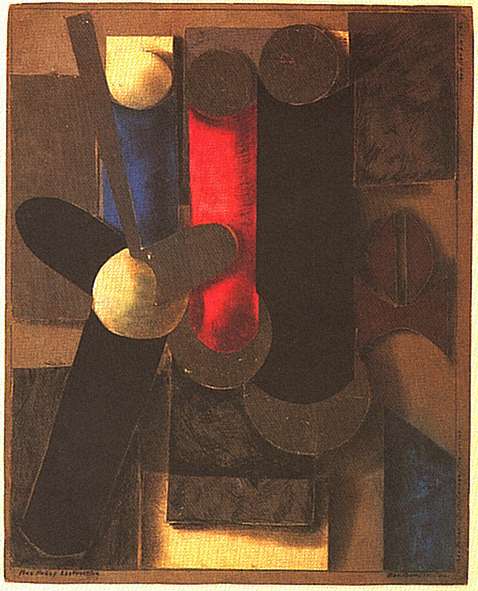
Plate 1
Ben Berlin, Duck-Cannon-Firecrackers, 1936.
Paper and foil collage on board, 19 7/8 × 16
in. The Buck Collection, Laguna Hills, California.
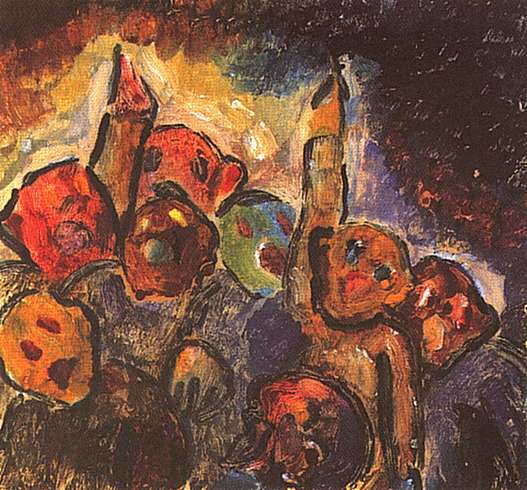
Plate 2
Edward Hagedorn, The Crowd , n.d. Monoprint/
oil on paper, 11 × 15 in. Getty Center for the His-
tory of Art and the Humanities. © Denenberg
Fine Arts, Inc., San Francisco.
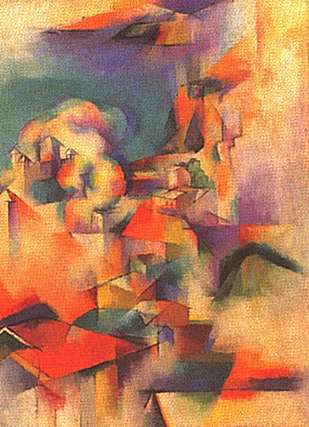
Plate 3
Stanton Macdonald-Wright,
California Landscape , ca. 1919.
Oil on canvas, 30 × 22 1/8 in.
Columbus Museum of Art,
Ohio. Gift of Ferdinand Howald.
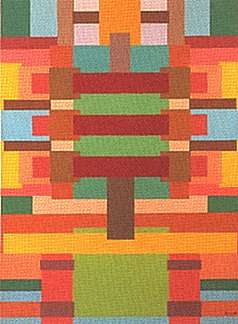
Plate 4
Peter Krasnow, K-1 ,
1944. Oil on board,
48 × 36 in. San Fran-
cisco Museum of Mo-
dern Art, gift of the
artist. Photograph by
Ben Blackwell.
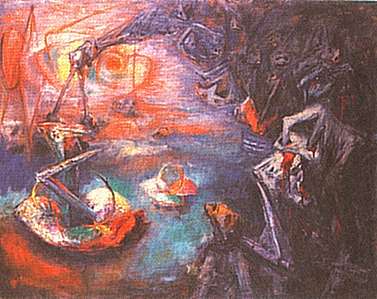
Plate 5
Above: Hans Burkhardt, VE Day ,
1945. Oil on canvas, 42 × 52 in.
Photograph courtesy Jack Rutberg
Fine Arts, Los Angeles.
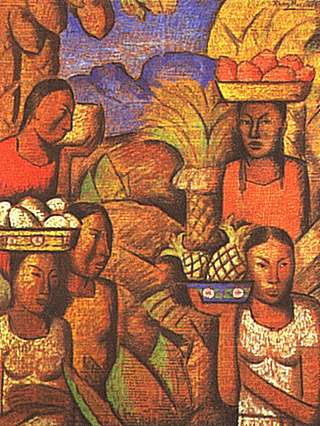
Plate 6
Right: Alfredo Ramos Martínez,
Vendedora de Frutas (Fruit Seller ),
1938. Tempera on newsprint, 21 ×
16 in. Mimi Rogers Collection, Los
Angeles, courtesy Louis Stern Galleries.
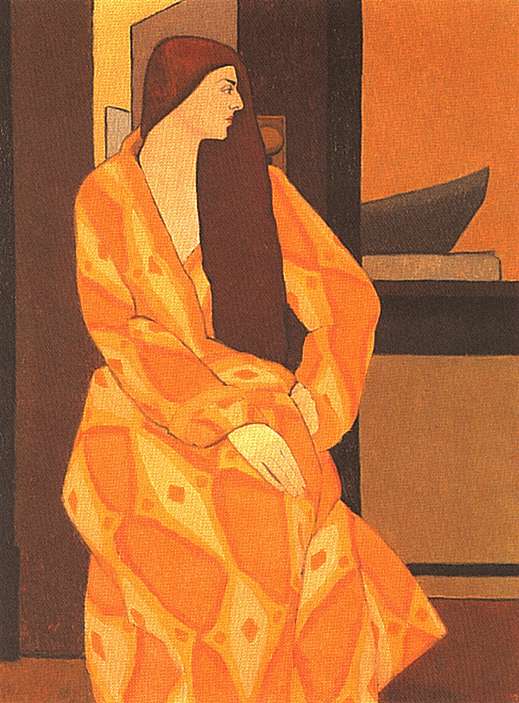
Plate 7
Opposite: Belle Baranceanu, The Yellow Robe ,
1927. Oil on canvas, 44 1/8 × 34 in. San Diego
Museum of Art, gift of the artist.
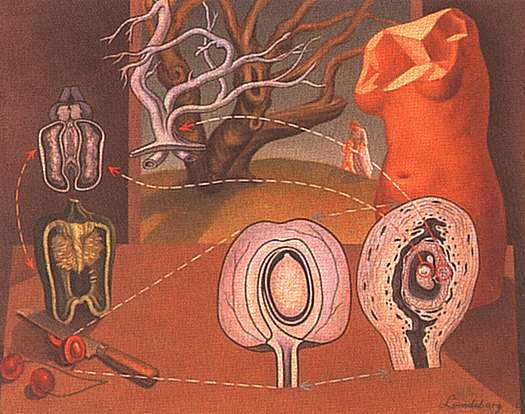
Plate 8
Helen Lundeberg, Plant and Animal Analogies ,
1934-35. Oil on celotex, 24 × 30 in. The Buck
Collection, Laguna Hills, California.
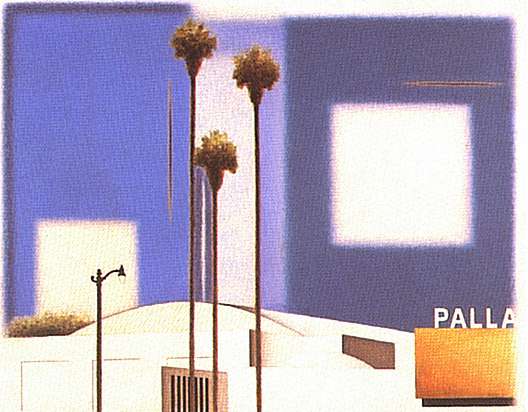
Plate 9
Edward Biberman, The Hollywood Palladium ,
ca. 1955. Oil on celotex on board, 36 × 48 in.
Private collection, Los Angeles. Photograph
© Douglas M. Parker Studio, Los Angeles,
courtesy Tobey C. Moss Gallery, Los Angeles.
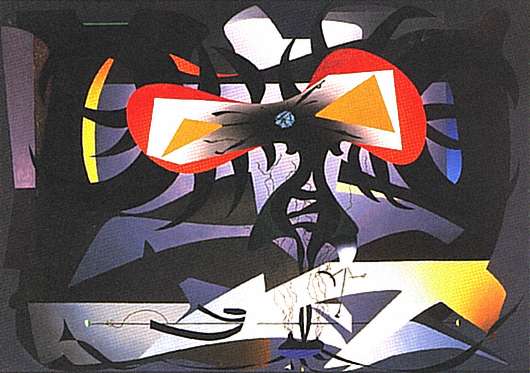
Plate 10
Charles Howard, The Progenitors ,
1947. Oil on canvas, 24 3/8 × 34½ in.
Fine Arts Museums of San Francisco,
Mildred Anna Williams Collection.
Pach and his wife spent the academic year 1942-43 in Mexico, where Pach lectured under the auspices of the Institute for International Education. While his reasons for leaving New York may have been partly financial, Pach was warmly received in Mexico. Shortly after his arrival, the artist Carlos Mérida broadcast a radio essay publicly welcoming him to Mexico and giving a synopsis of Pach's article on Bustos. Letters to Pach from Jean Lipman of Art in America , John Strasser, and the painters John Sloan and Marcel Duchamp allude to his activity among the Mexican intelligentsia and artists. After returning to the United States, Pach delivered a lecture in Los Angeles, at the Earl Stendahl Galleries, on ancient and modern Mexican art.
In 1943, as Pach organized an exhibition of Rivera's work, scheduled for February 1944, at the Arts Club of Chicago, a group—consisting of Inés Amor, director of the Galería de Artes Mexicanas; Francisco Orozco Muñoz, director of the National Museum; Eduardo Villaseñor, director of the Bank of Mexico; Diego Rivera; José Clemente Orozco; Alfonso Noriega, Jr., secretary of the National University; and Octavio G. Barreda, editor of the magazine Hijo Pródigo —addressed a letter, dated June 9, 1943, to the Minister of Foreign Affairs, Ezequiel Padilla, asking that he name Walter Pach Mexico's cultural representative in the United States. They cited both the urgent need for cultural representation in the United States, given that "the American Government (. . . seems to be interested in better relations and there are indications that they are ready to appropriate funding for this purpose)," and Pach's reputation there. As "a native he could develop cultural propaganda without it being viewed as a paid assignment or as a foreign view; he could address his audience not as 'you,' but rather, as 'we.' " They underscored Pach's importance as a supporter of Mexican art in the United States:
Mr. Walter Pach, a famous painter, . . . author of nine books on art, as well as 200 articles, a student of the ancient art of Mexico for more than a quarter century, came to our National University by special invitation of Pedro Henríquez Urena. . . .
Upon his return to New York, he immediately organized a Mexican exhibition which for the first time, presented painters such as Diego Rivera, José Clemente Orozco and David Alfaro Siqueiros and it must be said that it was he who successfully introduced our contemporary school of painting in the United States.[5]
Unfortunately for both American and Mexican art, nothing came of this petition.
The Walter Pach papers contain Pach's correspondence with Rivera, Orozco, and Charlot, among others. The letters Pach received from Mexico from 1922 to 1945 suggest the affection and respect the Mexican artists felt for him and show how he acted as an agent and cultural emissary for them. In the late forties the correspondence from Mexico diminished. After Pach's death his writing and critical approach went out of fashion and he was largely forgotten.
Pach's activity as a patron and advocate of Mexican art in the United States demands further investigation, for his wide-ranging interests and correspondence offer tantalizing glimpses into the relationships between Mexican artists and the international art scene. He was, moreover, an independent emissary, a person involved with art and artists for their sake alone. Although he was a friend of the Rockefellers, he was not involved with the foundations or with those institutions whose interest in Mexican art usually developed because of a political or economic self-interest.
Finally, Pach's bicoastal activities—his contacts with the California scene—indicate his awareness of the aesthetic differences between New York and the West Coast. As scholars explore the art scene in California during the twenties and thirties, it becomes increasingly evident from the lively gallery activity and the number of artists working in the state that art in Los Angeles was not dormant, or dull and provincial. Gallery spaces included the Biltmore Gallery, Barker Brothers, the Kanst Gallery, the Assistance League Gallery, the Friday Morning Club, the Ebell Club, Jake Zeitlin's Gallery Bookstore, Stanley Rose's Centaur Gallery, the Howard Putzel Gallery, the Frances Webb Gallery, and the Stendahl Galleries. In 1932 California Arts and Architecture magazine published a directory of California artists, craftsmen, designers, and art teachers.
A major contrast between the two coasts, however, and one that is still being assessed, involves the differences between the two areas as a result of California's shared history with Mexico and her geographical proximity, both issues in the interest shown by local artists in things Mexican. During the twenties in particular, some of these artists traveled to Mexico on painting trips, and local exhibitions often featured the works that resulted.[6]
But a contradiction remained between this appreciation of Mexico and its culture and the harsh reality of the discrimination against the Mexican population in California. Nonetheless, in 1923 Los Angeles was host to the first exhibition of Mexican art in the United States, a show organized by Xavier Guerrero, an artist who worked with Diego Rivera on the government-sponsored mural projects. Entitled The Arts and Crafts of Mexico , and sponsored by the Mexican government, the exhibition was held at the McDowell Club on Hill Street. It featured watercolors and drawings by Guerrero, Adolfo Best Maugard, and pupils of the art schools of Mexico. Originally it was to tour the United States, but because of problems with the United States Customs Office, it returned directly to Mexico from Los Angeles.
As a result of this exhibition, Guerrero first met Tina Modotti, who was then living in Los Angeles. Married to Roubaix de L'Abrie Richey, a French-Canadian poet, Modotti was performing minor roles in Hollywood films. Their studio was a center of bohemian life, frequented by the photographer Edward Weston, the writer Sadakichi Hartmann (who sometimes used the pseudonym Sidney Allan), and, in 1921, the Mexican archaeologist Ricardo Gómez Robledo. The relationship between Guerrero and Modotti was to flourish in Mexico after her separation from Edward Weston and during the time that she posed as a model for Rivera's Chapingo murals.[7]
These glimpses into the connections of Mexican and California artists suggest the need for a broader view of art and social history. In 1925 the Los Angeles County Museum at Exposition Park inaugurated a new wing with the First Pan American Exhibition of Oil Paintings . Opening on November 2, it was scheduled to close on January 31, 1926, but was held over until the end of March because of its popularity. Eighteen thousand people visited it on the first Sunday it was open to the public. It presented 230 artists from the United States and Canada and 145 Latin Americans. The artists from the United States included Thomas Hart Benton, Conrad Buff, Mary Cassatt, Alson Clarke, Maynard Dixon, George Ennis, Childe Hassam, Robert Henri, Rockwell Kent, Guy Rose, John Sloan, and Ralph Stackpole. The twenty-nine Mexicans included Jean Chariot, Joaquín Clausell, Fernando Leal, Roberto Montenegro, Juan O'Gorman, and Diego Rivera.
Of the Latin Americans, the Mexicans were the most strongly represented, both in works displayed and in prizes awarded. The Los Angeles Museum Prize ($1,500) went to Diego Rivera for his painting Día de Flores (Fig. 44). The museum announcement says that "Sr. Rivera is a leader of a modern group in Mexico—'Syndicate of Painters.' Walter Pach, the critic, calls him one of the greatest living artists." The Earl Stendahl Prize for landscapes in the Latin American section was divided between Manuel Villareal (Mexico) and Manuel Cabré (Venezuela). The Bivouac Art Club of the Otis Art Institute Prize for portrait or figure painting in the Latin American section was shared by Luis Martínez (Mexico) and María Ramírez Bonfiglio (Mexico).
During the 1920s the painter, muralist, and sculptor Francisco Cornejo, a native Baja Californian who lived and worked in San Francisco in his "Aztec" Studio, and the sculptor Luis Ortiz Monasterio, the father of Mexican modernist sculpture, collaborated on a theatrical work, Xochiquetzal . Originally performed in San Francisco by the Denis-Shawn Company, the work was staged at the old Philharmonic Auditorium on the corner of Fifth and Hill Streets in 1925. Cornejo also executed one of the side stages of the Mayan Theatre, a landmark of downtown Los Angeles.
Six years later, after murals had been completed at Pomona and San Francisco (José Clemente Orozco's Prometheus , 1930, and Diego Rivera's Allegory of California , the Stern mural, and Construction , 1930-31), two more exhibitions of Mexican art were held in Los Angeles. The first, a city-sponsored show held in conjunction with the August 1931 Fiesta de Los Angeles, was housed in the Plaza Art Center (renovated by R. M. Schindler) on Olvera Street. Facilitated by the Delphic Studios and the Weyhe Galleries of New York, it was curated by E K. Ferenc, the center's director, and Jorge Juan Crespo, who was then teaching art at the Chouinard Institute. The exhibition (135 works representing twenty-eight artists) included works by Cantú, Chariot, Clausell, Crespo, Pablo O'Higgins, Leal, Roberto Garcia Maroto, Siqueiros, Orozco, Mérida, Atl, Rivera, Julio Castellanos, Manuel Rodríguez Lozano, and five mural panels by Cueva del Río.
The second show was the Mexican arts show organized by the Rockefeller Founda-
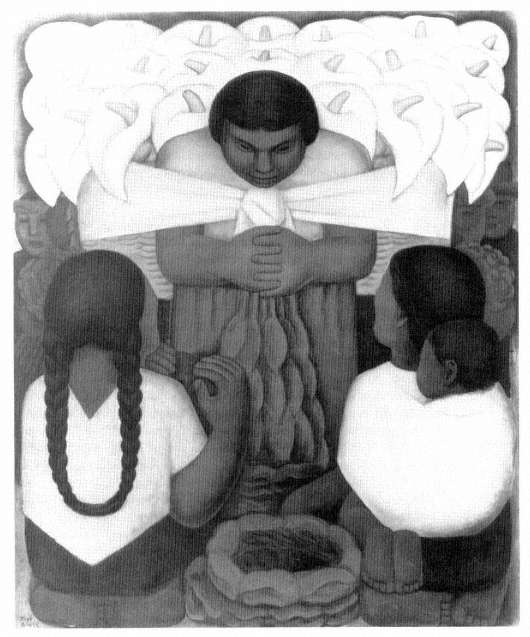
Figure 44
Diego Rivera, Día de Flores (Flower Day ), 1925. Oil on canvas, 58 × 47½ in.
Los Angeles Count)' Museum of Art, Los Angeles County Fund.
tion and former ambassador Dwight Morrow at the Metropolitan Museum of Art in 1930-31. Opening October 4, 1931, in Los Angeles, it featured lectures by the curator, René d'Harnoncourt, and by Homer Saint-Gaudens of the Carnegie Foundation and received a generous review in the Los Angeles Times by Arthur Millier.
The final "legitimizing" event for Mexican art in 1931 was a lecture, "The Revolution in Art Today," by the eminent French critic Elie Faure at the California Arts Club. In it, he recommended a new direction for American philanthropy:
Much as I love Spain, . . . I can call her conquest of the Aztecs nothing less than brutal. Yet, after the conquest, popular and individual expression of art arose in delightful and gracious forms which continue to the present day.
. . . I cannot understand why Americans who give millions for the restoration of Versailles, do not spend a few millions for the excavation of the . . . temples of Central America and for . . . museums which might be the greatest in the world. You have an obligation in that those Aztecs are your real ancestors, for people are related to the land the), live in rather than to their racial stocks.
But the visual presence of Mexican art went beyond exhibitions and lectures. It involved a continuity of influence through artists who taught, wrote, and created art in Los Angeles, introducing modernist aesthetics as well as fresco painting and muralism. It is difficult, however, to assess the importance of such figures as Jorge Juan Crespo, Alfredo Ramos Martínez, Francisco Cornejo, and Jean Chariot in easel painting, muralism, and sculpture. Even the influence of more famous artists, such as David Alfaro Siqueiros, has only partially been studied.
Painter, muralist, and art writer Jorge Juan Crespo taught at Chouinard from 1930 to 1938 with, in 1931, Richard Neutra and Hans Hofmann. Also in 1931 he curated the exhibition of Mexican art at the Olvera Street Gallery and executed for the Sons of Italy Hall a series of murals that disappeared before they could be documented. His writings on emerging European modernists in such catalogues as those produced by the Earl Stendahl Galleries reveal another aspect of the Mexican influence. Most Mexican artists had lived or studied in Europe before coming to Los Angeles. Thus they provided for the West Coast an alternative view of modern art, one that differed from that of the Atlantic seaboard.
Two important figures, Alfredo Ramos Martínez and Jean Chariot, had played major roles in the Mexican visual renaissance before moving to Los Angeles in 1930. Ramos Marténez had studied, lived, and worked in Paris before returning to Mexico in 1910.[8] The Open Air Painting Schools he founded, based on the Barbizon School principle, were probably the single most important influence on the School of Mexican Painting, for through them the study of art became available to everyone. Indeed, one of Ramos's first pupils at the school, established in 1913, was David Alfaro Siqueiros, who never forgot the debt he owed this master. Ramos also served as director of the
National Academy of Fine Arts. He first visited Los Angeles in 1925, when he accompanied an international exhibition of works from his schools to the First Pan American Exhibition. There he met William Alanson Bryan, then the director of the Los Angeles Museum of History, Science and Arts; when he returned in 1930, it was Bryan who facilitated his first exhibition.
Upon arriving in Mexico from France in 1922, Jean Chariot, who had studied painting and lithography in his native country, was invited to begin a woodblock workshop at one of the Open Air Painting Schools in Chimalistac, a suburb of Mexico City. There he introduced his technique, which he had acquired from the German expressionists. In doing so, he gave new impetus to the Mexican graphic movement, which had begun with José Guadalupe Posada at the beginning of the century. He worked with Rivera on the murals at the Ministry of Education, but as Rivera became the dominant muralist, Chariot and others turned to other fields of activity[9]
The sense of nationalism that pervaded Mexican painting by the mid-twenties may have motivated Chariot to come to the United States. It may have influenced Ramos as well, for José Clemente Orozco had criticized both the Open Air Painting Schools (because they were based on a European model) and Ramos himself. But the condition of his infant daughter may also have brought Ramos to the United States, for he had been advised that the regions dry climate was most suitable for the child. He arrived in Los Angeles with his wife and daughter in 1930, settled down, and began to work.
What is astonishing about Ramos's subsequent work is the shift in subject matter and technique. By experimenting with space and volume and exploring themes that had never before surfaced in his work, Ramos became a major exponent of the School of Mexico (see Plate 6). Even more intriguing is his acceptance by the art community in Los Angeles even as his contributions to the history of art in Mexico were being forgotten; they have only recently been reaffirmed. His first solo exhibition, at the Assistance League Gallery, featured works in the style that was to become associated with his name in California. They are characterized by a strong linear composition and reveal his preference for a palette rich in ochers and brownish tones in his portraits, in contrast with that of the flowers he sometimes included in his portraits and in his still lifes.
By 1933 Ramos had been commissioned to paint a mural at the home of the Hollywood screenwriter Jo Swerling. The year before, David Alfaro Siqueiros, at the invitation of Nelbert Chouinard, had come to Los Angeles to conduct mural workshops, and Ramos had taken him to meet E K. Ferenc, the director of the Olvera Street Gallery. That meeting led to Siqueiros's commission to paint the notorious mural Tropical America , but beyond that, it brought both painters in contact with a group of Hollywood intellectuals, including Swerling, Dudley Murphy, and John Huston, who supported their work and, in Siqueiros's case, his philosophy of using art for social change and revolution. The Swerling mural attracted other patrons, including Corinne Griffith, Edith Head, Alfred Hitchcock, and Beulah Bondi. In 1934 Ramos executed a set of murals for the Santa Barbara Cemetery commissioned by Mrs. George Washington
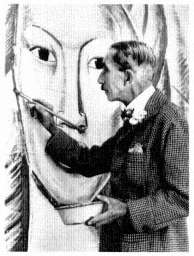
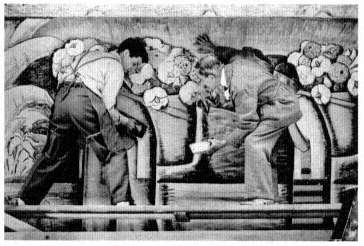
Figures 45 - 47
This page and next: Alfredo Ramos Martínez working oil the mural
in the Margaret Fowler Garden at Scripps College, 1946. Photographs
by Max Yavno. Courtesy Millard Sheets Estate, lent by Paul Bockhorst.
Smith, the widow of the famous architect, and the violinist and composer Henry Eichman; and in 1936, he painted a mural for the oratory of the Chapman Park Hotel (now destroyed).
A quiet man, Ramos was befriended by his peers, who admired him. Hugo Ballin introduced Ramos at his exhibition in the Santa Monica Library in 1933, and one of the first artists to visit him upon his arrival in Los Angeles was Leo Katz. But the most important of Ramos's artist friends was Millard Sheets, with whom he had a lifelong friendship. It was Sheets who arranged the commission for the Margaret Fowler Memorial Garden mural at Scripps College in Claremont (Figs. 45-47). Ramos completed it shortly before his death.
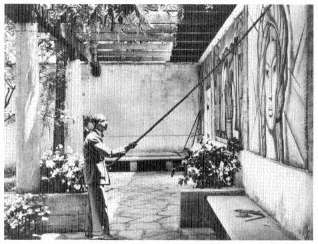
Charlot's stay in Los Angeles was much briefer than Ramos's, but during the years he was there, 1930-38, he worked steadily with the lithographer Lynton Kistler in his Culver City Studio (Fig. 48). In 1936 Charlot and Kistler presented an exhibition of prints at the Santa Barbara Library, showing works by Paul Landacre, Dan Lutz, Phil Paradise, Millard Sheets, and Henrietta Shore. The affection and esteem for Chariot in Los Angeles is evidenced by the farewell dinner arranged for him at Taix Restaurant, attended by the artists Lucille Lloyd, Sheets, Conrad Buff, Beatrice Wood, Alson Clarke, Paul Sample, Stanton Macdonald-Wright, and Kistler; the art writers and critics Rob Wagner, Harry Muir Kurzworth, and Arthur Millier; the gallery directors and owners Jake Zeitlin, William Alanson Bryan, and Dalzell Hatfield; and the collectors and patrons Jean Hersholt, Josef yon Sternberg, and William Preston Harrison.
In his conception of both art and the aesthetic experience Jean Chariot foreshadowed contemporary aesthetics; he posited a historical continuity that originated with the pre-Columbian aesthetic. During his years in Mexico, he traveled extensively to the Yucatán, and his incorporation of Mayan concepts of minimalism and monumentality is apparent in his graphic line (Fig. 49)- He explored these same ideas in his writings. and his book The History of Art from the Mayas to Walt Disney is an early attempt to incorporate non-Western and popular art forms into mainstream art history. A vigorous, energetic, and imaginative man, he eventually moved to Hawaii; he taught at the university there before his death in 1979.
David Alfaro Siqueiros executed three murals in the city that exemplified his aesthetic objective: to use art for social and political purposes. The most controversial. Tropical America , treated contemporary Latin American political life and denounced North American imperialism. Of all the controversies over works of art in California during the thirties, the one over this mural left the most lasting impression. The mural itself was whitewashed in 1934 and then covered over because the owner of the Sons of Italy Hall, the building on which it was painted, thought it "ugly." When it became a
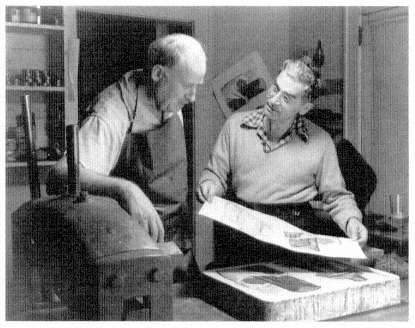
Figure 48
Above: Jean Chariot (left ) and Lynton Kistler in Kistler's studio,
1950. Photograph courtesy Tobey C. Moss Gallery, Los Angeles.
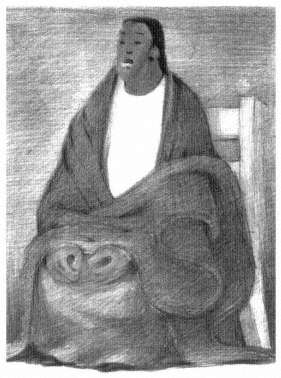
Figure 49
Jean Charlot, Luz , from Pictwe Book No. 1 , Plate 9, 1932-33.
Color offset lithograph, 8 × 6 in. Photograph courtesy
Tobey C. Moss Gallery, Los Angeles.
rallying point for the Chicano-Latino artists and community, efforts were made to preserve it, and it is now being restored.
Siqueiros's influence (as well as that of Orozco, Rivera, and Ramos Martínez) on the Los Angeles muralists, particularly Leo Katz, Boris Deutsch, Lucille Lloyd, Fletcher Martin, and Hugo Ballin, is undeniable. Murals executed by Katz (particularly the controversial Los Angeles Trade Technical School mural) include the socio-political themes common in the work of the Mexican muralists; Ballin's Los Angeles Times murals and those he painted for the old Department of Water and Power Building at 511 West Fifth Street reveal a careful analysis of Rivera's Detroit Institute of Arts frescoes in their linear construction and spatial composition as well as in the theme of workers in a new industrial age. Lucille Lloyd's Origin and Development of the Name of the State of California reveals similar modernist thematic and stylistic influences.
Siqueiros's political orientation gave impetus to the socio-political polemics that flourished in the Los Angeles art community around 1936, when there were sharp divisions between the Internationalists, who opposed the fascist threat in Europe, and the "American" artists, who were essentially isolationists. Passions were fueled by Siqueiros's workshops and by his 1934 lecture at the John Reed Club as well as by discussions at the 1936 American Artists Congress in New York. The "American" group, supported by the Stendahl Galleries, was led by Lorser Feitelson and Helen Lundeberg; the Internationalists, sponsored by the Stanley Rose Gallery, included Leo Katz, Edward Biberman, and Knud Merrild.
During the 1920s and 1930s the Mexican artists were never marginalized or ignored in Los Angeles. Instead, they contributed in a meaningful way to the vibrant local culture and shared a commitment to developing an aesthetics suited to the time. Influential as they were, however, they were themselves influenced by the Los Angeles aesthetic and cultural ambience—Ramos Martínez, in particular. He made an extraordinary shift in his conception of space and volume in his paintings in response to the works of the sculptor George Stanley (for example, the monumental Griffith Park Astronomers and the modernist-style Oscar statuette).
The last important Mexican exhibition of the twenties and thirties in Los Angeles was The Indefinite Period (1942), a traveling show organized by McKinley Helms at the Institute of Modern Art in Boston. In it were works by Rufino Tamayo, Antonio Ruiz, Carlos Orozco Romero, Dr. Atl, María Izquierdo, Frida Kahlo, Jesús Guerrero Galván, Federico Cantú, and Guillermo Meza, some of whom (Izquierdo, Meza) were exhibiting for the first time in Southern California.
The next exhibition was not until 1953. The migrants who came from the Midwest and the East Coast during the war years looking for work in the growing aircraft industry created a different climate, in which things Mexican were viewed with suspicion Incidents such as the Zoot-suit riots and the Sleepy Lagoon murder case helped to eradicate the goodwill established during two decades of cross-cultural influences. The focus of American art, and thus American art history, shifted eastward. As it did, the Mexican artists and their work faded from memory, and an important part of Southerr California's cultural history was almost forgotten.